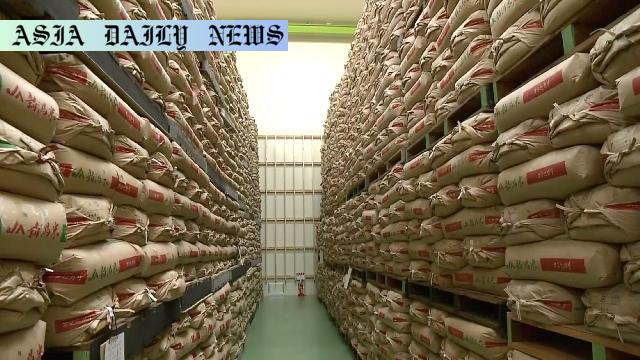Rice Prices: Japan to release 210,000 tons of reserve rice to stabilize prices amid significant market demand and distribution challenges.
- Japan’s agriculture ministry plans to release 210,000 tons of reserve rice to address high domestic prices.
- 150,000 tons will be offered for initial bidding, while the remaining stock is based on future assessments of market conditions.
- This release aims to counter last year’s drop in purchases by wholesalers and stabilize the market.
- The government typically reserves rice for emergencies but is now releasing it for smoother distribution.

Introduction: The Need for Market Intervention
In an unprecedented move, the Japanese government has decided to release 210,000 tons of government reserve rice into the market. This decision comes against a backdrop of steadily rising rice prices and challenges in distribution. As Japan’s staple food, rice is central to the daily lives of its citizens, and fluctuations in price can have wide-ranging implications for consumers and producers alike. This initiative highlights the government’s proactive efforts to stabilize the market while addressing a decline in inventory purchases by wholesalers in the previous year.
Details of the Planned Rice Release
The agriculture ministry has strategically decided to allocate 150,000 tons of rice from the 2024 harvest for initial sale via bidding. Additionally, a portion of rice harvested in 2023 will also be included in the release. This marks the first instance when reserve rice is being released to stabilize distribution and prevent further price escalation. In principle, the government plans to repurchase the same quantity of rice released within a year to maintain a steady stockpile.
A Balancing Act for Demand and Supply
Rice production in 2024 is anticipated to increase by 180,000 tons compared to the previous year. However, this optimistic forecast is juxtaposed with a decrease of 210,000 tons in the purchase of rice by Japan Agricultural Cooperatives and other wholesalers in 2023. The significant drop in purchases caused a strain on the market, creating the current need for intervention. This release of reserve rice seeks to bridge this gap, aiming to normalize market dynamics and support farmers and consumers in equal measure.
Historical Context: Reserve Rice Policy
Historically, the Japanese government has maintained a policy of keeping one million tons of rice in reserve. This reserve has primarily been used as a contingency for natural disasters or poor harvests. The current decision to release rice for market stability marks a shift from the usual policy, demonstrating greater adaptability in managing market fluctuations. By breaking tradition, the government is emphasizing its commitment to ensuring food security and economic balance.
Implications for the Rice Industry
The release of reserve rice is likely to have both immediate and long-term implications. In the short term, it is expected to reduce rice prices and ease the burden on consumers. For distributors and retailers, this move could ensure smoother inventory replenishment and prevent supply-chain disruptions. On the other hand, farmers may face challenges in adjusting to potential price fluctuations caused by the additional supply. Such ripple effects will need to be carefully monitored to ensure that the intervention achieves its intended goal of market equilibrium.
Public and International Attention
While this move is primarily targeted at domestic markets, it is expected to garner international attention. Japan’s rice policies have often been under scrutiny due to their impact on global trade dynamics. Any significant policy shift in Japan’s agricultural sector can influence rice-exporting countries and global markets. Additionally, the domestic public will closely watch how this decision impacts their daily lives and household budgets, given the cultural and economic significance of rice in Japanese society.
Conclusion
The Japanese government’s announcement to release 210,000 tons of reserve rice signifies a dynamic response to an evolving economic challenge. This proactive measure is aimed at addressing high rice prices and ensuring stable distribution. As the plan unfolds, its effectiveness will be determined by how well the government can manage the delicate balance between supply, demand, and market stability. This decision underscores the importance of adaptability in policymaking to safeguard economic and food security for the public.



Commentary
A Bold Move to Stabilize Rice Prices
It is encouraging to see Japan’s government taking decisive action to stabilize rice prices, a staple food that affects households and industries alike. The release of 210,000 tons of reserve rice demonstrates not only a willingness to intervene in the market but also an acknowledgment of the challenges arising from declining purchases by wholesalers. This balanced approach, which considers both the supply chain and consumers’ needs, highlights the importance of government oversight in essential commodity markets.
The Fine Line Between Intervention and Market Dynamics
While the decision to release the rice reserve is commendable, it raises questions about potential long-term implications. Will this intervention create dependency on government support, or will it stabilize supply chains to function more autonomously in the future? Furthermore, ensuring that farmers’ interests are protected amidst price adjustments is crucial. Policymakers must tread carefully, as even well-intentioned interventions can have unintended consequences.
Looking Ahead: Challenges and Opportunities
This move offers an opportunity for the government to reassess its stockpile policies and consider more flexible frameworks for agricultural reserves. It also sets a precedent for the future, paving the way for similar interventions if market dynamics call for them. As the situation unfolds, the public and international markets alike will watch closely for the impact of this decision on rice prices and broader economic stability.
Conclusion
Ultimately, the release of reserve rice is a bold and necessary step in navigating the challenges of rising prices and market disruptions. It demonstrates a government that is attentive to its people’s needs and willing to adapt its approach to evolving circumstances. Whether this move will achieve its intended objectives remains to be seen, but it undeniably sets a positive example of proactive governance in times of economic uncertainty.